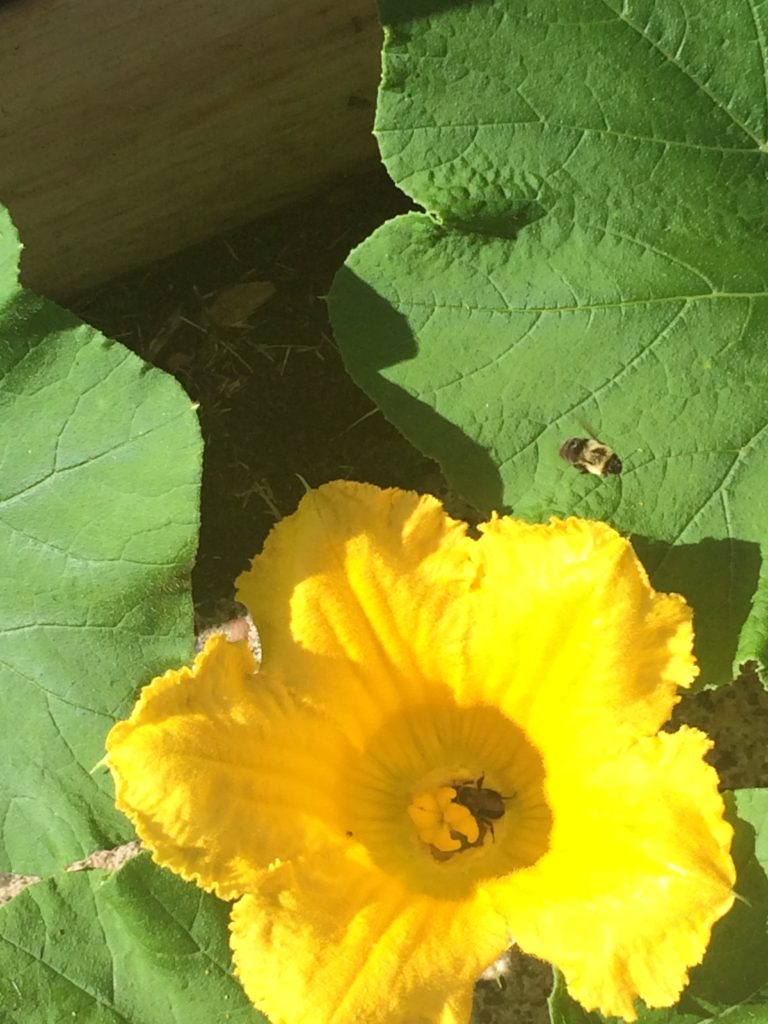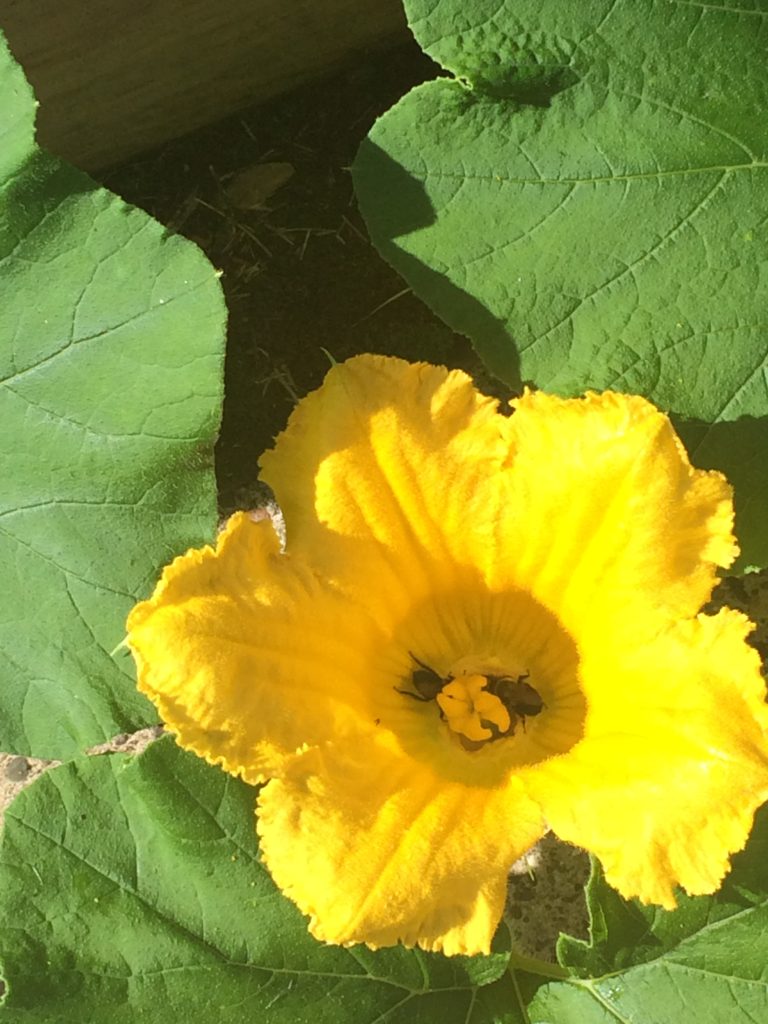To Christopher Robin
When Winnie the Pooh and you
walked all over the hundred-acre
wood, his sniff, sniff, sniffing
to find honey was on the money.
I have not met a bear, anywhere
who could compare to Pooh.
How does he do it?
His prowess to find a hive and dive
deep into that golden heaven—created
while we sleep by bees who keep working
to create the sweetness we love and need.
Wow. Pooh is a rare bear, indeed.
~Annette Gagliardi
I was taking a walk one morning this past week and we spied not one, but two bees inside a squash blossom. First of all, the beautiful yellow blossom was huge. Second, it was attracting bees like spilled syrup on a picnic table. Several bees were buzzing around the garden set on a neighborhood boulevard and I was amazed to see two bees fly into the flower at the same time.

Those bees immediately had me thinking of honey and my cousin Cathy Jo (and her husband, of course) who run a bee-keeping business. She sent me a few resources for my readers who want to know more about bees, beekeeping and honey. They are honey experts, bee experts and help us to understand how important keeping bees alive is to our own survival.
The Amazing Honeybee: Honey bees are the only insects that produce food for humans. (From: http://minnesotahoneyproducers.org/)
I love a touch of honey in my tea, or a drizzled over warm scones. Honey on hot corn bread is heaven. A plain peanut butter sandwich becomes very satisfying, indeed when honey is added to the bread. I bet you have your own favorite when it comes to ingesting honey.
Have you ever eaten Mexican ice cream? – Start with a ball of hard-frozen ice cream, roll in a cereal-cinnamon crunch, deep-fry and drizzled with honey. YUM! (I’ve put the link to A Taste of Home recipe below.)
Honey, the sweetest natural sugar, is also good for you! Honey is sweeter than table sugar because of its high fructose content so you can use less of it than you would sugar. It also contains various trace minerals, enzymes and antioxidant properties, so it’s better for you. If you want to cook with honey, you can replace about half of the sugar with about 2/3 that amount of honey. In baked goods, add ½ tsp baking powder per cup of honey used. Also, reduce the oven temperature about 25 degrees for foods with honey.
Nature’s Gold: The benefits of honey go beyond its great taste; it’s a great natural source of carbohydrates which provide strength and energy to our bodies. There are more than 300 unique types of honey available in the United States, each originating from a different floral source. (From: http://minnesotahoneyproducers.org/)
Honey is a sweet, viscous substance made by honey bees (mostly) who produce honey from plant nectar or from honeydew, (which is special secretions from other insects.) The best-known and most widely used honey comes from the honey production of the genus Apis, Honey Bees.
An aside about honeydew: Honeydew is a sugar-rich, syrupy liquid secreted by several hemipteran insects (not bees). Ants, as well as bees collect from honeydew producers, which benefit from their presence because they drive away predators. There is much to learn about honeydew. Its production and collection provides an insight into the inter-workings of the world of insects of which many of us have very little knowledge.
I remember Dad bringing home a honeycomb from a bees nest he found in the woods, when I was about eight-years-old. He put the comb and dripping honey into a cake pan. Mom separated most of the honey from the wax and filled a couple jars full of the golden syrup. We all had fresh honey on buttered bread. It was wonderful. What I remember, more than the sweetness of the honey, was that we kids got to chew the wax and we had our own natural chewing gum! It was sweet and the wax stuck a little to our teeth, but what a great, natural gum.
Most of us know about honey being edible, but beeswax is too, and is approved for food use in most countries. The wax is used to make candles, because beeswax burns readily, brighter, longer, more cleanly, and it does not bend—which makes it superior to other wax candles.
Apiculture:
There are well-organized commercial and educational businesses, world-wide that collect domesticated and wild honey. They are called beekeepers or apiculture.
Honey has about the same relative sweetness as table sugar. One US tablespoon of honey provides around 190 kilojoules (46 kilocalories) of food energy. Over its history as a food, the main uses of honey are in cooking, baking, desserts, as a spread on bread, as an addition to various beverages such as tea, and as a sweetener in some commercial beverages.
Honey a natural antioxidant:
Honey is also added to creams and soaps for its natural antioxidants and humectant properties – which means it absorbs moisture from the air. Raw (unpasteurized) honey helps balance the bacteria on your skin, which makes it great for reducing acne, or healing psoriasis and eczema. There are also claims that honey will help fade scars. Honey speeds up the skin’s healing process. It is a natural exfoliator, which helps us understand how it can speed up the healing process.
Honey is hygroscopic, which means it absorbs water from the atmosphere, from materials with which it is in contact, and most importantly, it desiccates to death any microorganisms that fall into it, which makes it an antiseptic.
ALLERGY WARNING: If you have allergic reactions to pollen, celery, or other bee-related products, steer clear of using honey on your skin.
Honey’s use and production have a long and varied history even into ancient times. Because of its composition and chemical properties, honey is suitable for long-term storage—and I’m talking really long-term. Honey, and objects immersed in honey, have been preserved for centuries. There are 8,000-year-old cave paintings in Spain (in Cuevas de la Arana) that show humans looking for – and finding honey.
Articles from the National Geographic and the Smithsonian note 3,000-year-old honey they found in the pyramids of Egypt. The good news is that the honey was still edible. In addition, honey stains found in ceramic vessels in the Republic of Georgia are believed to be made by bees that lived there some 5,500 years ago. That find is 2,000 years older than the honey found in Egyptian Pharaoh Tutankhamen’s tomb, and has been considered the oldest honey ever found.
In addition to finding ceramic jars filled with honey, V I Ps were often embalmed in honey to help preserve their bodies.
I am curious about how (and how much) that 3,000-year-old honey, or even 5,500-year-old honey differs from current day honey. Given the same type of bees consuming similar plant life – what has changed over those many passed years? Do we even have the same type of bees today?
Honey doesn’t spoil because of its low moisture content and in a way it’s like aging cheese sealed in wax. Sealed (ripened) honey is 17% moisture and bacteria can’t live/grow in it. It also has a low pH. The key to honey preservation is limiting access to humidity. In its cured state, honey has a sufficiently high sugar content that inhibits fermentation, however the long self-life of honey is actually from an enzyme found in the bees’ stomach. Bees mix glucose oxidase with nectar they have previously consumed and expelled. This creates two by-products: gluconic acid and hydrogen peroxide, (I always wondered where hydrogen peroxide came from :D). These two by-products are partially responsible for the acidity of honey and the suppression of bacterial growth.
Collecting a bit of sweetness:
Honey is collected from wild bee colonies or from domesticated beehives. On average, one domesticated beehive will produce about 65 pounds of honey per year (or about 29 kilograms)
World-wide production of honey was 1.9 million tonnes, in 2018. A tonne is a metric unit of mass equal to 1,000 kilograms and is commonly referred to as a metric ton. A Tonne is equivalent to approximately 2,204.6 pounds
To safely collect honey from a hive, beekeepers typically pacify the bees using a bee smoker. The smoke triggers a feeding instinct (an attempt to save the resources of the hive from a possible fire), making them less aggressive, and obscures the pheromones the bees use to communicate. The honeycomb is removed from the hive and the honey may be extracted from it either by crushing or by using a honey extractor. The honey is then usually filtered to remove beeswax and other debris.
Before the invention of removable frames, bee colonies were often sacrificed to conduct the harvest. The harvester would take all the available honey and replace the entire colony the next spring. Since the invention of removable frames, the principles of bee-husbandry led most beekeepers to ensure that their bees have enough stores to survive the winter, either by leaving some honey in the beehive or by providing the colony with a honey substitute such as sugar water or crystalline sugar. The amount of food necessary for bees to survive the winter depends on the variety of bees and on the length and severity of local winters.
Pollination: One third of our food supply is directly dependent upon honeybee pollination. Commercial beekeepers move honeybees across the country to satisfy the needs of growers. (From: http://minnesotahoneyproducers.org/)
Today I am making scones to go with our tea, which is a 3-4 pm ritual at our house. Yes, we will have honey for our tea—and our scones. Honey is the darling of sweetness. Enjoy a bit today.
Resources:
“Benefits of using Honey on your skin” at Healthline https://www.healthline.com/health/honey-for-face
Encyclopedia Britanica at: https://www.britannica.com/animal/hymenopteran
“Honey” by Wikipedia https://en.wikipedia.org/wiki/Honey
“Honey in the Pyramids” by National Geographic at: https://www.nationalgeographic.com.au/history/honey-in-the-pyramids.aspx
Taste of Home Mexican Ice Cream at: https://www.tasteofhome.com/recipes/mexican-ice-cream/ Or with graham cracker instead of cereal flakes, check this out: https://www.tasteofhome.com/recipes/graham-cracker-fried-ice-cream/
“The Science Behind Honey’s Eternal Shelf Life” By Smithsonian Magazine, at: https://www.smithsonianmag.com/science-nature/the-science-behind-honeys-eternal-shelf-life-1218690/
Resources from Cathy Jo:
National Honey Board at: https://www.honey.com/
Sioux Honey Association at: https://siouxhoney.com/
Minnesota Honey Producers association at: minnesotahoneyproducers.org
Cathy -The Honeylady is at: https://www.facebook.com/crufer60
Publications:
“Will the Rusty Patched Bumble Bee become our ‘State Bee’?” by the Minnesota Extension services at: https://blog-yard-garden-news.extension.umn.edu/2019/04/will-rusty-patched-bumble-bee-become.html
“American Bee Journal” at: https://americanbeejournal.com/
“Bee Culture Magazine” The magazine of American Beekeeping at: https://www.beeculture.com/
“Growing landscapes to help bees and other pollinators” by University of Minnesota Extension service at: https://extension.umn.edu/lawns-and-landscapes/flowers-pollinators
Adult Books:
“Covered in Honey” by Mani Niall(chef)
“First Lessons in Beekeeping” Dadant and Sons
“Honey from Flower to Table” by Stephanie Rosenbaum
Children Books:
“Buzz” by Eileen Spinelli
“The Honeybee Man” by Lela Nargi
“The Bee Tree” by Patricia Polacco
“Winnie The Pooh’s Plan Bee” (A story of friendship.) by Alarie Tennille
Teachers Resource:
“Buzzing A Hive” University of California at Berkeley
Bee Supplies and Educational Materials:
Dadant and Sons at: https://www.dadant.com/catalog/
Mann Lake Supply at: https://www.mannlakeltd.com/beekeeping-education

You girls did a great job with lots of information.
Annette our blog was fantastic! I could not have said it better myself! Honey is a natural and I hope folks buy only USA honey and always support a local beekeeper! It is great for indigestion, super for healing and tastes good too! I love the “A Honey of a Day!” You are so talented!
I meant your blog, I do not know how to fix that! I am sorry! ❤️❤️❤️ Dear cousin!!